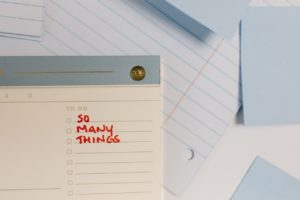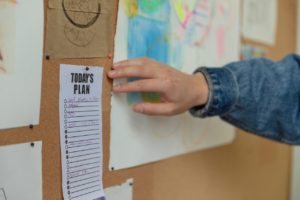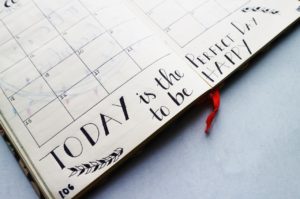
Being a good teacher is hard at any time. Being a good teacher during a pandemic is nearly impossible. The tasks seem to multiply, but the time to do them seems to diminish by the day.
I wish I could wave a magic wand and give you fewer tasks to do and more time to do them.
Since I can’t do that, I’ll try to give you some actionable tips to deal with your monumental to-do list.
1 – First, make a list of everything you need to do on a daily basis. Write down every single thing – taking attendance, prepping for each class or lesson, checking email. Everything.
When you’re done, first congratulate yourself for all that you are getting done every single day. Then, take another look at that list and see if there is anything on the list that could be simplified, done less frequently, delegated to someone (a teaching assistant? a student teacher? your students?) or deleted altogether.

As you look for items to simplify, think about how you might “batch” some tasks. Batching means doing all of the same kinds of tasks at the same time. Some examples: making all of your copies one day a week instead of making copies daily; writing your detailed reading group lesson plans at one time (even though you may still need to tweak them, based on what you see your students do in the group); doing all the prep work for a subject on one day, all the prep work for another subject on another day, etc.

2 – Next, make a list of everything you need to do on a weekly basis. Again, write down every single thing.
Do the same things with this list that you did with the daily list. Congratulate yourself first! Then see if anything on the list can be simplified, done less frequently, delegated, or deleted.

If these tasks should be done on certain days, list the day beside the task. For example: maybe you send a parent newsletter or email on Friday. If so, you might want to do the actual writing of the newsletter or email on Wednesday or Thursday so that it will be ready to send on Friday.
On this list, put a star or asterisk beside any time that takes less than 15 minutes to complete. You’ll use that code for your daily to-do list in tip #4 below.

3 – Start a running projects list. For this list, write down everything you think you need to do or that you want to do for your classroom. These projects should not be items on your daily/weekly tasks lists. These projects are “extra.” Keep adding to this list as you think of things. If there is something in particular that you really want to do soon, put a star beside it, highlight it, anything that will draw your attention to it.

The purpose of this list is to clear your mind of things you think of that you want to do at some point, but that can tend to overwhelm you when you think of adding them to your already overcrowded to-do list. These items can be added to your to-do list when/if you have the time some week. If you never get to them, that’s okay too – they are not required tasks.

4 – When you’re ready to make your daily to-do list, keep the numbers 1-3-5 in mind.
Write down 1 “big” task for the day (i.e., planning your next writing unit, completing report cards, etc.). You might want to take a look at the list of your weekly tasks for this item. This item might also be something from your running projects list.
Then write down 3 “medium” tasks for the day. These tasks might take more than 15 minutes, but not more than 30 minutes (i.e., creating math slides for the next day’s lesson, planning your reading groups for the next day, etc.).

Finally, write down 5 “small” tasks for the day. The small tasks should take less than 15 minutes (i.e., respond to emails, create agenda for a PLC meeting, etc.). Take a look at your weekly list of starred tasks as you make this list.

Some people like to keep this list separate from their daily to-do items from tip #1 above. Other people like to list it all on one page so they can see all the little things they accomplish in a day. I personally LOVE to check items off a list, so this works for me. Other people prefer to see a shorter, more streamlined list. Do what works best for you!

5 – Recognize that, on some days, those 1-3-5 tasks might not all get done. If this seems to be a pattern for most of your days, change the numbers to 1-2-3 instead. Give yourself grace! Also, recognize that just getting all those daily to-do tasks done is an accomplishment in itself.

6 – When you’ve got that daily list ready to go, indicate beside each task WHEN you’re going to try to get it done. Before school? During a prep period? After school? Doing this helps you to be a bit more realistic about how much you might be able to get done on a particular day.
It’s okay to postpone tasks for another day if you see that this day will not have as much time for completing tasks. By the way – if you want some printable lists, here’s my inexpensive option.

7 – Give yourself grace. Some years, and some times of the year, are just going to be hard. At those times, you have to let some things go and do the best you can.
Simplify whatever you can, batch tasks as best you can, do some tasks less frequently, delegate whatever you can, and delete whatever you can. YOU and your energy management are what is most important.
Do what you can and do not try to be a super-teacher. The fact that you show up every day to do this work means you are already a super-teacher. Be kind to yourself first.

